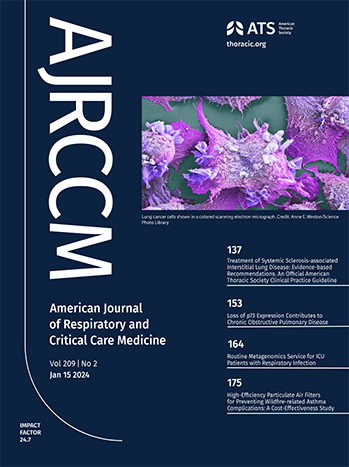镰状细胞病长期生存的心肺血流动力学决定因素:来自ETENDARD研究的见解
IF 19.4
1区 医学
Q1 CRITICAL CARE MEDICINE
American journal of respiratory and critical care medicine
Pub Date : 2025-09-12
DOI:10.1164/rccm.202502-0353oc
引用次数: 0
摘要
肺动脉高压(PH)是镰状细胞病(SCD)的一种严重的心肺并发症,但血液动力学参数对预后的影响仍不明确。目的本研究旨在评估SCD血流动力学参数的临床和长期预后相关性。方法对来自法国标准队列的数据进行分析。所有398名参与者都接受了超声心动图检查;三尖瓣反流速度(TRV)≥2.5 m/s者行右心导管术。在至少10年的随访中,我们检查了血流动力学变量的临床和预后意义。测量和主要结果44例(11%)患者被确定为平均肺动脉压(mPAP) bbb20 mmHg定义的高血压。其中26例(6.5%)肺动脉楔压(PAWP)≤5 mmHg, 18例(4.5%)肺动脉楔压(PAWP)≤15 mmHg。随访期间死亡率为11.1%。肺血管阻力(PVR)水平与死亡风险之间存在显著关联,通过ROC分析确定阈值为1.5 Wood单位。在mPAP bbb20 mmHg和PVR≥1.5 WU的患者中,调整后的死亡率风险比(HR)为4.27 (95% CI: 1.88-9.74; p < 0.001)。溶血表型和全身性并发症的存在,包括高血压、左心室舒张功能障碍、肾功能损害和腿部溃疡,与PVR升高和死亡风险增加有关。结论:在mPAP高于20mmhg的患者中,1.5 WU的PVR阈值是死亡率的关键预测指标,特别是当与溶血和全身并发症标志物一起评估时。本文章由计算机程序翻译,如有差异,请以英文原文为准。
Cardiopulmonary Hemodynamic Determinants of Long-Term Survival in Sickle Cell Disease: Insights from the ETENDARD Study.
RATIONALE
Pulmonary hypertension (PH) is a serious cardiopulmonary complication of sickle cell disease (SCD), but the prognostic impact of hemodynamic parameters remains poorly defined.
OBJECTIVES
This study aimed to assess the clinical and long-term prognostic relevance of hemodynamic parameters in SCD.
METHODS
Data were analyzed from the French Etendard cohort. All 398 participants underwent echocardiography; those with tricuspid regurgitation velocity (TRV) ≥ 2.5 m/s proceeded to right heart catheterization. Over a minimum 10-year follow-up, we examined the clinical and prognostic significance of hemodynamic variables.
MEASUREMENTS AND MAIN RESULTS
PH defined by a mean pulmonary arterial pressure (mPAP) > 20 mmHg was identified in 44 patients (11%). Among them, 26 (6.5%) had a pulmonary arterial wedge pressure (PAWP) ≤ 5 mmHg, and 18 (4.5%) had a PAWP>15 mmHg. Mortality during follow-up was 11.1%. A significant association was found between pulmonary vascular resistance (PVR) levels and mortality risk, with a threshold identified at 1.5 Wood units through ROC analyses. In patients with mPAP > 20 mmHg and PVR ≥ 1.5 WU, the adjusted hazard ratio (HR) for mortality was 4.27 (95% CI: 1.88-9.74; p < 0.001). A hemolytic phenotype and the presence of systemic complications, including hypertension, left ventricular diastolic dysfunction, renal impairment, and leg ulcers, were associated with elevated PVR and increased mortality risk.
CONCLUSION
A PVR threshold of 1.5 WU emerges as a key predictor of mortality in patients with a mPAP above 20 mmHg, particularly when assessed in conjunction with markers of hemolysis and systemic complications.
求助全文
通过发布文献求助,成功后即可免费获取论文全文。
去求助
来源期刊
CiteScore
27.30
自引率
4.50%
发文量
1313
审稿时长
3-6 weeks
期刊介绍:
The American Journal of Respiratory and Critical Care Medicine focuses on human biology and disease, as well as animal studies that contribute to the understanding of pathophysiology and treatment of diseases that affect the respiratory system and critically ill patients. Papers that are solely or predominantly based in cell and molecular biology are published in the companion journal, the American Journal of Respiratory Cell and Molecular Biology. The Journal also seeks to publish clinical trials and outstanding review articles on areas of interest in several forms. The State-of-the-Art review is a treatise usually covering a broad field that brings bench research to the bedside. Shorter reviews are published as Critical Care Perspectives or Pulmonary Perspectives. These are generally focused on a more limited area and advance a concerted opinion about care for a specific process. Concise Clinical Reviews provide an evidence-based synthesis of the literature pertaining to topics of fundamental importance to the practice of pulmonary, critical care, and sleep medicine. Images providing advances or unusual contributions to the field are published as Images in Pulmonary, Critical Care, Sleep Medicine and the Sciences.
A recent trend and future direction of the Journal has been to include debates of a topical nature on issues of importance in pulmonary and critical care medicine and to the membership of the American Thoracic Society. Other recent changes have included encompassing works from the field of critical care medicine and the extension of the editorial governing of journal policy to colleagues outside of the United States of America. The focus and direction of the Journal is to establish an international forum for state-of-the-art respiratory and critical care medicine.

 求助内容:
求助内容: 应助结果提醒方式:
应助结果提醒方式:


